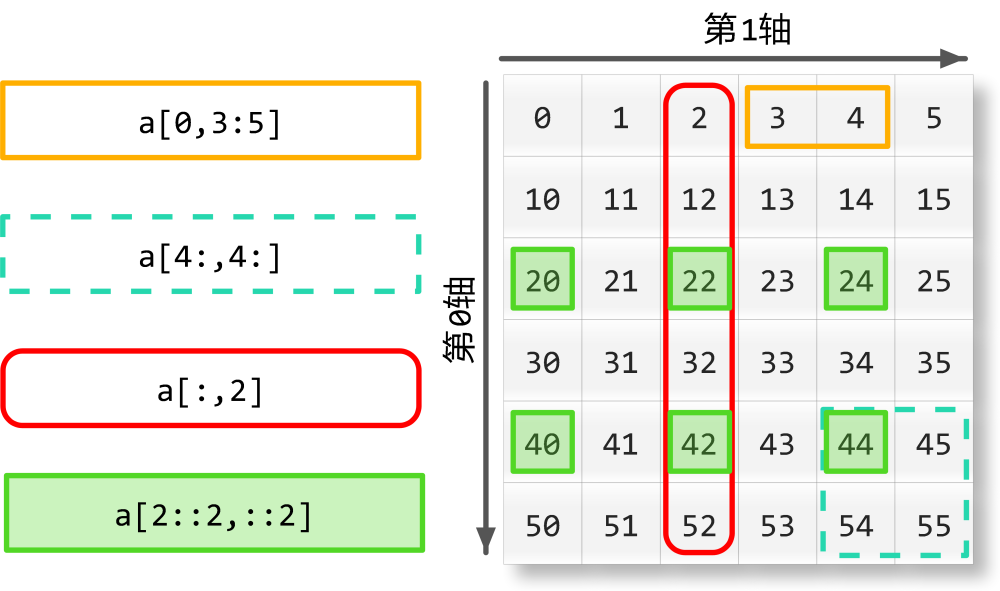numpy中的tile函数:
遇到numpy.tile(A,(b,c))函数,重复复制A,按照行方向b次,列方向c次。
>>> import numpy >>> numpy.tile([0,0],5)#在列方向上重复[0,0]5次,默认行1次 array([0, 0, 0, 0, 0, 0, 0, 0, 0, 0]) >>> numpy.tile([0,0],(1,1))#在列方向上重复[0,0]1次,行1次 array([[0, 0]]) >>> numpy.tile([0,0],(2,1))#在列方向上重复[0,0]1次,行2次 array([[0, 0], [0, 0]]) >>> numpy.tile([0,0],(3,1)) array([[0, 0], [0, 0], [0, 0]]) >>> numpy.tile([0,0],(1,3))#在列方向上重复[0,0]3次,行1次 array([[0, 0, 0, 0, 0, 0]]) >>> numpy.tile([0,0],(2,3))<span style="font-family: Arial, Helvetica, sans-serif;">#在列方向上重复[0,0]3次,行2次</span> array([[0, 0, 0, 0, 0, 0], [0, 0, 0, 0, 0, 0]])
python中的sum函数.sum(axis=1)
当加入axis=1以后就是将一个矩阵的每一行向量相加
a = np.array([[0, 2, 1]]) print a.sum() print a.sum(axis=0) print a.sum(axis=1) 结果分别是:3, [0 1 2], [3] b = np.array([0, 2, 1]) print b.sum() print b.sum(axis=0) print b.sum(axis=1) 结果分别是:3, 3, 运行错误:'axis' entry is out of bounds 可知:对一维数组,只有第0轴,没有第1轴 c = np.array([[0, 2, 1], [3, 5, 6], [0, 1, 1]]) print c.sum() print c.sum(axis=0) print c.sum(axis=1) 结果分别是:19, [3 8 8], [ 3 14 2]

浅述python中argsort()函数的用法
1.先定义一个array数据
1 import numpy as np 2 x=np.array([1,4,3,-1,6,9])
2.现在我们可以看看argsort()函数的具体功能是什么:
x.argsort()
输出定义为y=array([3,0,2,1,4,5])。
我们发现argsort()函数是将x中的元素从小到大排列,提取其对应的index(索引),然后输出到y。例如:x[3]=-1最小,所以y[0]=3,x[5]=9最大,所以y[5]=5。
Python 字典(Dictionary) get()方法
描述
Python 字典(Dictionary) get() 函数返回指定键的值,如果值不在字典中返回默认值。
语法
get()方法语法:
dict.get(key, default=None)
参数
- key -- 字典中要查找的键。
- default -- 如果指定键的值不存在时,返回该默认值值。
返回值
返回指定键的值,如果值不在字典中返回默认值None。
items()和iteritems()区别:
字典的items方法作用:是可以将字典中的所有项,以列表方式返回。因为字典是无序的,所以用items方法返回字典的所有项,也是没有顺序的。
字典的iteritems方法作用:与items方法相比作用大致相同,只是它的返回值不是列表,而是一个迭代器。


核心代码解读:
# inX:用于分类的输入向量 # dataSet:输入的训练样本集 # labels:标签向量 # k:用于选择最近邻的数量 def classify0(inX, dataSet, labels, k): # 距离计算 dataSetSize = dataSet.shape[0] #数据的条目数 #c.shape[1] 为列的数量,c.shape[0] 为行的数量。 diffMat = tile(inX, (dataSetSize,1)) - dataSet sqDiffMat = diffMat**2 sqDistances = sqDiffMat.sum(axis=1) #将每一列相加 distances = sqDistances**0.5 # 将距离值按照从小到大排序 sortedDistIndicies = distances.argsort() classCount={} # 取出前k个元素 for i in rangs(k): # 取出对应的label voteIlabel = labels[sortedDistIndicies[i]] #计算当前取出的label的数量 #对标签A、B分别进行统计计数 classCount[voteIlabel] = classCount.get(voteIlabel,0) + 1 # 逆序排列label对应总数的列表 返回对应的label sortedClassCount = sorted(classCount.iteritems(),key=operator.itemgetter(1), reverse=True) #iteritems()是把字典里面的元素,返回一个迭代器 #key=operator.itemgetter(1),按照第1个值(即第二个统计到的个树值)进行排序 #reverse=True,True时将按降序排列 return sortedClassCount[0][0]